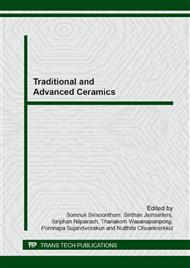[1]
M.V. Popa, et al., Corrosion susceptibility of implant materials Ti-5Al-4V and Ti-6Al-4Fe in artificial extra-cellular fluids, Electrochim. Acta. 49 (2004) 2113-2121.
DOI: 10.1016/j.electacta.2003.12.036
Google Scholar
[2]
I. Cvijović-Alagić, Z. Cvijović, S. Mitrović, V. Panić and M. Rakin, Wear and corrosion behaviour of Ti-13Nb-13Zr and Ti-6Al-4V alloys in simulated physiological solution, Corros. Sci. 53 (2011) 796-808.
DOI: 10.1016/j.corsci.2010.11.014
Google Scholar
[3]
E.M. Szesz, et al., Electrochemical and morphological analyses on the titanium surface modified by shot blasting and anodic oxidation processes, Thin Solid Films. 528 (2013) 163-166.
DOI: 10.1016/j.tsf.2012.09.096
Google Scholar
[4]
Y. Huang, Q. Luo, X. Li, F. Zhang and S. Zhao, Fabrication and in vitro evaluation of the collagen/hyaluronic acid PEM coating crosslinked with functionalized RGD peptide on titanium, Acta Biomaterialia. 8 (2012) 866-877.
DOI: 10.1016/j.actbio.2011.10.020
Google Scholar
[5]
L. Aloia Games, et al., Chemical and mechanical properties of anodized cp-titanium in NH4 H2PO4/NH4F media for biomedical applications, Surf. Coat. Technol. 206 (2012) 4791-4798.
DOI: 10.1016/j.surfcoat.2012.03.092
Google Scholar
[6]
I.M. Pohrelyuk, V.M. Fedirko, O.V. Tkachuk and R.V. Proskurnyak, Corrosion resistance of Ti-6Al-4V alloy with nitride coatings in Ringer's solution, Corros. Sci. 66 (2013) 392-398.
DOI: 10.1016/j.corsci.2012.10.005
Google Scholar
[7]
W.F. Ho, C.H. Lai, H.C. Hsu and S.C. Wu, Surface modification of a low-modulus Ti-7. 5Mo alloy treated with aqueous NaOH, Surf. Coat. Technol. 203 (2009) 3142-3150.
DOI: 10.1016/j.surfcoat.2009.03.042
Google Scholar
[8]
R.G. Wilks, et al., Characterization of oxide layers formed on electrochemically treated Ti by using soft X-ray absorption measurements, J. Electron Spectrosc. 169 (2009) 46-50.
DOI: 10.1016/j.elspec.2008.11.001
Google Scholar
[9]
N. Masahashi, S. Semboshi, N. Ohtsu and M. Oku, Microstructure and superhydrophilicity of anodic TiO2 films on pure titanium, Thin Solid Films. 516 (2008) 7488-7496.
DOI: 10.1016/j.tsf.2008.03.047
Google Scholar
[10]
N. Eliaz, et al., The effect of surface treatment on the surface texture and contact angle of electrochemically deposited hydroxyapatite coating and on its interaction with bone-forming cells, Acta Biomaterialia. 5 (2009) 3178-3191.
DOI: 10.1016/j.actbio.2009.04.005
Google Scholar
[11]
H.S. Seo, B.H. Kim and Y.M. Ko, Fabrication of anodized titanium with immobilization of hyaluronic acid to improve biological performance, Prog. Org. Coat. 69 (2010) 38-44.
DOI: 10.1016/j.porgcoat.2010.05.001
Google Scholar
[12]
J.U. Kim, Y.H. Jeong and H.C. Choe, Morphology of hydroxyapatite coated nanotube surface of Ti-35Nb-xHf alloys for implant materials, Thin Solid Films. 520 (2011) 793-799.
DOI: 10.1016/j.tsf.2011.04.169
Google Scholar
[13]
D. M. Brunette, P. Tengvall, M. Textor and P. Thomsen, Titanium in Medicine, Germany, (2001).
Google Scholar
[14]
Z.B. Xia, et al., Crystallization of the anodic oxide on titanium in sulphuric acids solution at a very low potential, Electrochem. Commun. 9 (2007) 850-856.
DOI: 10.1016/j.elecom.2006.11.027
Google Scholar
[15]
Y.T. Sul, et al., Characteristics of the surface oxides on turned and electrochemically oxidized pure titanium implants up to dielectric breakdown: the oxide thickness, micropore configurations, surface roughness, crystal structure and chemical composition, Biomaterials. 23 (2002).
DOI: 10.1016/s0142-9612(01)00131-4
Google Scholar


